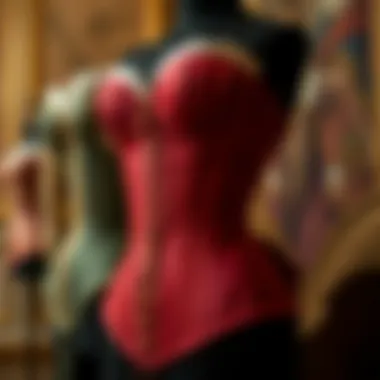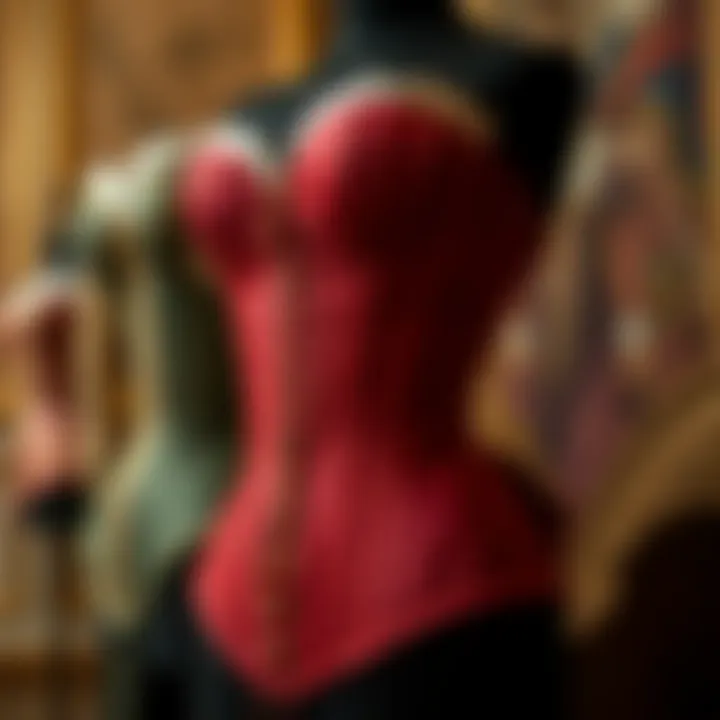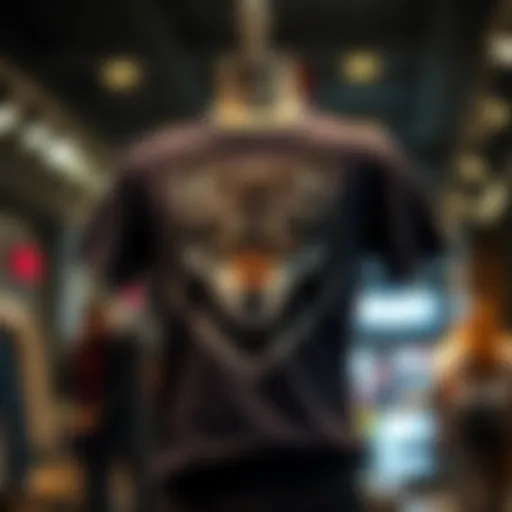Corsets and Tummy Control: A Modern Perspective


Intro
Corsets, once a staple in women's wardrobes across centuries, have evolved dramatically in their purpose and perception. Originally designed primarily to shape and support the body, these garments now interplay between bodily aesthetics and functionality, particularly for tummy control. Today, they are not just viewed as historical relics but have resurfaced in modern fashion, marketed as tools for enhancing the silhouette while potentially offering support.
Understanding the role of corsets involves looking beyond merely fashion. It's a conversation about health, body image, and the nuanced relationship between clothing and personal empowerment. For many, corsets can provide that extra touch of confidence, helping individuals to achieve the waistline they desire. Yet, misconceptions persist about their practicality and impact on health. This overview aspires to dissect these aspects, providing insights into not just how to wear a corset but why one might choose to incorporate it into their daily attire.
As we navigate through the intricacies of tummy control with corsets, we will explore their historical context, contemporary applications, and the balance of beauty and well-being. This guide aims to equip fashion designers, stylists, bloggers, and retailers with the knowledge they need to approach corsetry responsibly within today’s fashion ecosystem.
Historical Overview of Corsets
The historical overview of corsets plays a critical role in understanding how these garments evolved from mere clothing items to symbols of fashion, beauty, and identity. The journey of corsets through time not only reflects changes in style but also reveals the societal values and norms surrounding women's bodies. This historical context provides the foundation for modern applications and perceptions of corsets for tummy control. Analyzing the roots and transformations of corsets helps demystify their functionality and cultural significance today.
Origins of the Corset
The origins of the corset trace back to ancient times, as early as the 16th century, when women began to wear garments that shaped their bodies to enhance their silhouettes. Initially, these were not termed corsets but rather bodices. Materials like linen and leather were commonly used, sewn tightly to achieve an hourglass figure. The term "corset" emerged later, in France, indicating a shift towards a standardized garment designed to mold the torso.
The corset's purpose was not only aesthetics; it also served functional roles as a supportive undergarment, especially during the early days of its use.
Evolution Through the Ages
As time marched on, corsets underwent significant redesign, fundamentally changing in shape, function, and even ideology. In the 17th century, corsets were often waist-length and heavily boned, signaling the start of a long evolution characterized by varying degrees of constriction and embellishment. By the 18th century, they became longer, extending downwards and embellishing them with elaborate fabrics and trims. The Victorian era marked the high point of corsetry with extreme hourglass silhouettes fueled by the wasp waist aspiration.
However, the 20th century saw a significant backlash against the restrictive designs of underlying garments, especially post-World War I. The corset became viewed as an instrument of oppression, which prompted a relaxation in the fit and a gradual decline in its popularity. Tracing this evolution, one finds layers of complexity influencing both women’s fashions and societal perspectives on body image.
Cultural Significance
The cultural significance of corsets is not to be overlooked. Throughout history, they have symbolized more than just fashion; they embody the shifting paradigms of femininity and societal expectations. In different eras, corsets have defined beauty standards, often sparking debates around femininity, health, and autonomy.
- In some societies, wearing a corset was a rite of passage into womanhood, signaling maturity and desirability.
- Conversely, during feminist movements, corsets were often dismissed as relics of patriarchy, leading to their association with female oppression.
Today, the cultural narrative around corsets is multifaceted, blending empowerment with aesthetic consideration. They can signify control over one's appearance, thus serving as a tool that empowers women to shape their identities in ways that align with contemporary values. Notably, understanding this cultural context enhances the appreciation of corsets in modern wardrobes, especially as they offer tummy control solutions that cater to both form and function.
Functionality of Corsets for Tummy Control
Corsets serve a dual purpose in the world of fashion; while they certainly offer an aesthetic appeal, their functionality in tummy control is equally, if not more, significant. Understanding the importance of this topic goes beyond the superficial; it requires examining the elements that confer both shape and support. Corsets designed for tummy control do not just mold the figure—they can enhance posture, boost confidence, and serve as a powerful tool in achieving desired body contours.
Design and Structure
When it comes to tummy control, the design and structure of a corset can vary widely. A well-designed corset is typically crafted with several key features that promote its functionality:
- Boning: Steel or plastic boning provides necessary support to shape the torso. Steel provides a sturdiness that can hold up under pressure, making it ideal for long-term wear. Plastic, on the other hand, offers flexibility but might not provide the same level of compression.
- Waist Tape: This is crucial in maintaining the desired shape, as it reinforces the waist area, keeping the corset snugly in place without adding unnecessary pressure.
- Lacing System: A traditional lacing system not only allows for adjustable fitting but also creates a customizable silhouette, ensuring that the corset molds to the wearer’s unique body shape.
- Length: The length of the corset can greatly affect its effectiveness; longer corsets will provide coverage and control for the lower abdomen, while shorter styles may focus more on the waist.
The combination of these elements enhances the garment's functionality, allowing it to sculpt the body effectively while also promoting health through improved posture.
Materials and Technology
Materials and technology play a pivotal role in the efficacy of corsets intended for tummy control. Traditional corsets were often made from cotton or silk; recently, advancements have led to the incorporation of modern materials that enhance comfort and performance. Some of these include:
- Breathable Fabrics: Newer corsets often utilize breathable meshes and fabrics that wick moisture away from the skin, providing comfort during extended wear.
- Neoprene Layers: Used in some tummy-control corsets, neoprene offers compression while still allowing for movement, which is essential for daily wear. This modern material helps in creating a smoother silhouette without sacrificing comfort.
- Smart Fabric Technology: Some innovative brands are now exploring smart fabrics that adjust to body temperature, providing optimal comfort and support throughout the day.


Choosing the Right Corset
Selecting the appropriate corset is pivotal for achieving both comfort and style. The right choice can enhance silhouette while allowing for ease of movement. Corsetry isn't just about squeezing your waist; it’s also about understanding your unique body shape and personal style preferences. Choosing wisely means you’ll reap benefits ranging from the visual appeal of the garment to its functional aspects in tummy control.
Sizing Considerations
One of the most crucial factors when choosing a corset is getting the sizing just right. Corsets are typically sized based on waist measurements, but it’s not as straightforward as it seems. Measuring correctly involves using a soft tape measure to find the circumference of your waist, making sure to also consider where on the waist you want the corset to sit—a bit higher or lower can significantly differ in fit and comfort.
Several brands have their sizing charts, so checking each one’s specifics is helpful. For instance, going up or down one size can drastically change the fit, so don’t hesitate to size up if you’re at the higher end of a measurement. Moreover, consider additional factors like body type and the amount of lacing you desire; this can dictate how much "wiggle room" you’ll need. Finding the right fit will be a game changer in your ability to wear a corset comfortably and effectively.
Styles and Cuts
When it comes to styles and cuts, corsets vary greatly, each designed for different aesthetics and levels of support. For example:
- Overbust Corsets: These offer support for the bust while shaping the waist and are excellent for formal wear.
- Underbust Corsets: Suitable for layering or casual wear, they sit beneath the bust, allowing for flexibility in outfitting.
- Longline Corsets: These extend down to the hips, providing more control over the midsection.
Each style has its purpose, depending on the outfit and occasion you aim to match. Fashion designers often play with the cuts and styles to create modern interpretations, making corsets suitable for a variety of events, from casual brunches to elegant galas. Knowing which style enhances your body shape can aid in making an informed decision, giving you the best of both worlds: aesthetics and functionality.
Budget and Quality
Lastly, budget and quality shouldn’t be overlooked in your corset quest. Corsets come in a vast range of prices, but remember that quality often comes at a cost. Cheaper options might seem tempting, but they can lack proper construction, leading to discomfort or even health issues. Look for reputable brands or workshops known for their craftsmanship and material durability.
Investing in a well-made corset means you’re not just buying a garment—you’re acquiring a piece that will provide consistent support and enhance your silhouette for years to come. It’s worth considering the long-term benefits of purchasing a higher quality product rather than frequently replacing cheaper versions.
"You get what you pay for" is a simple but true saying—especially in the world of fashion.
How to Wear a Corset Effectively
When it comes to corsets, knowing how to wear one effectively is vital for both comfort and style. A well-fitted corset can enhance the silhouette, creating that coveted hourglass shape. Yet, many individuals feel intimidated by the idea of lacing themselves into one of these garments. This section demystifies the process, providing essential tips, layering strategies, and maintenance advice. By adhering to these guidelines, you can ensure that your corset not only meets your aesthetic goals but also promotes a sense of well-being.
Fitting Tips
Getting the perfect fit with a corset is akin to a cozy pair of shoes. A poorly fitted corset can lead to discomfort, and worse, can impact your body negatively. Here are some key tips to consider:
- Measure Accurately: Always start with proper measurements. Measure your waist, bust, and hips to determine the right size. It's crucial to take into account your body type and proportions as they influence how the corset will conform to your figure.
- Find the Right Style: Different corset styles suit different body shapes. For example, a traditional Victorian corset may not be the best for someone with a petite frame. Consider modern options designed with various body types in mind.
- Try Before You Buy: Whenever possible, try on the corset. This helps in ensuring that it feels right and suits your needs. Pay attention to how it supports your figure and whether it allows for movement without restriction.
- Leave Room for Adjustment: Corsets come with lacing or hook-and-eye closures. Ensure there’s some flexibility for tightening or loosening as needed, facilitating comfort throughout long wear.
"A corset should feel like a gentle embrace, not a tight squeeze."
Layering with Other Garments
When integrating a corset into your wardrobe, layering is essential. It’s not just about looking good; it’s about feeling good in whatever you're wearing. Here are some strategies:
- Choose Complementary Fabrics: Pair your corset with materials that work harmoniously. For instance, a silk blouse under a sturdy overbust corset allows for a luxe finish while offering comfort.
- Experiment with Lengths: Corsets usually have a specific length. Layering with longer tops or dresses can help in achieving a more balanced silhouette. A flowing dress over a corset softens the overall look and avoids any harsh lines that may be unflattering.
- Focus on Color Coordination: Make sure the colors of your corset and layers blend well. Contrasting colors can be bold and fashion-forward, but monochromatic styles may offer an elegance that simplifies the ensemble.
- Consider Seasonal Styles: Heavy fabrics may be delightful in winter but can be stifling in summer. Adjust your layer choices based on the season to maintain comfort and aesthetic appeal.
Caring for Your Corset
A corset, like any favored garment, requires proper care to maintain its structure and prolong its life. Here’s a straightforward guide:
- Read Care Labels: Pay attention to the manufacturer's instructions. Some corsets are machine washable, while others may require hand washing or dry cleaning.
- Store Wisely: Avoid hanging your corset as this can stretch the fabric. Instead, lay it flat in a drawer or on a shelf, away from direct sunlight to prevent fading.
- Inspect Regularly: Periodically check for signs of wear, particularly on the laces and boning. If you notice any fraying or structural integrity issues, it might be time to consider repair or replacement.
- Rotate Usage: If you own multiple corsets, rotate their wear to prevent excessive wear on a single piece. This not only preserves each corset but allows you to enjoy the variety of styles.


By following these comprehensive guidelines on wearing a corset effectively, you can ensure that your experience is enjoyable. Whether it’s the way you feel in it or the way it shapes your attire, a corset can harmonize personal preferences with exquisite fashion.
The Impact of Corsets on Body Image
The influence of corsets on body image is a multifaceted topic that takes into account historical context, societal norms, and personal experiences. It’s not just about how a corset shapes the body physically; it is also about the psychological ramifications that accompany its use. Corsets have long been symbols of femininity and beauty, yet they can evoke a mix of empowerment and discomfort in today's world of shifting body ideals. Understanding this duality is essential for fashion designers and retailers aiming to create garments that resonate with their audience while still respecting individual choices and health considerations.
Cultural Pressures and Expectations
In society, the image of beauty is often dictated by cultural norms that change with time. Corsets, historically associated with the idealized hourglass figure, represent a specific aesthetic that many aspire to. However, the expectations surrounding this beauty standard can be tremendously burdensome.
Across various cultures, the corset is seen as a tool to meet these expectations. In many cases, women experience pressure to conform to certain body ideals, which can lead to a negative self-image. The corset can thus be viewed as a double-edged sword; while it can help in shaping the body to achieve a certain look, it can also perpetuate unhealthy perceptions about what a woman’s body should be. The positive aspect lies in the corset’s ability to enhance curves and promote self-confidence, but this is often overshadowed by fear of judgment.
Health Implications
The discussion around corsets inevitably reverts back to health. Historically, corsets have been associated with several health risks, such as restricted respiration and organ displacement. While contemporary corsetry tends to emphasize comfort and support, there remains a level of skepticism regarding the health implications involved.
"Fashion is made to become unfashionable." - Coco Chanel
Modern materials and designs allow for better breathing and more adjustable fit, ensuring that wearers are not subjected to the same physical constraints as those in the past. However, it is crucial for consumers to understand their own body needs. For instance:
- Breathability: Polyester and lace corsets generally allow for better airflow than traditional whale bone versions.
- Support: Look for boning that provides structure without compromising comfort.
- Duration of Wear: Wearing a corset for extended periods can lead to discomfort and muscle atrophy.
Awareness of these implications encourages informed decisions. Knowledge is power, and consumers equipped with the right information can enjoy the aesthetic advantages of corsets while prioritizing their health.
Empowerment vs. Constraint
The relationship between corsets and empowerment hinges on the mindset of the wearer. For many, donning a corset symbolizes control over one’s own body. It can serve as a way to challenge societal norms, allowing an individual to redefine their own beauty standards. A woman who wears a corset may feel a sense of empowerment in crafting her personal narrative and projecting confidence. Yet, with empowerment arrives the caveat of constraint.
The intricate balance between feeling empowered and feeling restricted is where many discussions on body image tend to clash. Individuals must evaluate their motives for wearing a corset:
- Self-Expression: Is the corset being used as a form of self-expression, or does it stem from the desire to fit into societal norms?
- Comfort Levels: Are you comfortable in your own skin without it, or do you feel inadequate without the waist trainer?
Corsets can empower women to reclaim their shape, making fashion an extension of their personality. However, recognizing when that empowerment converts to a sense of constraint is vital.
Common Misconceptions About Corsets
Corsets have long been shrouded in myths and misunderstandings. Unpacking these common misconceptions is key in comprehending how they fit into both fashion and personal health. Many view corsets solely through a lens of historical repression or extreme fashion trends, but the reality is much more nuanced. Understanding what is fact and what is fiction can not only shape perceptions but also influence choices for those considering adopting the garment.
Corsets and Health Risks
One of the most prevalent misconceptions surrounding corsets is the supposed health risks they pose. It is commonly believed that wearing a corset can cause severe harm to internal organs, restrict breathing, and even lead to long-term complications. The truth is more intricate. While it is crucial to wear a correctly fitted corset and not to over-tighten it, the risks associated greatly diminish when individuals take proper precautions.
Corsets can actually provide support for the back and improve posture when worn appropriately. They can be beneficial for certain body types, offering temporary tummy control without necessarily compromising health.
"Corsets, when used correctly, serve as functional garments that complement one's figure and lifestyle, rather than oppressing it."
However, some caution must be exercised. Here are a few considerations regarding health and corsets:
- Fitting is Key: A professionally fitted corset is crucial to avoid squeezing vital organs.
- Duration of Wear: Prolonged wear without breaks can lead to discomfort or health implications.
- Listening to Your Body: If one feels pain or respiratory issues, it is wise to adjust or remove the corset entirely.


Modern Usage and Adaptation
The landscape of corsetry has transformed dramatically in recent years. Gone are the days when corsets were solely linked with Victorian fashion. Today's corsets are subject to a wide array of interpretations and uses. Many people adapt the garment, wearing it as an accent piece rather than a constricting undergarment.
With styles evolving, designers are experimenting with various cuts and fabrics that resonate with contemporary fashion needs. Corsets are now seen incorporated into everyday attire, with a focus on beauty balanced with comfort. This adaptability has let corseting step away from its rigid historical associations. Modern styles may combine elements of corsetry with sportswear or casual looks, creating a new fusion that is both stylish and practical.
Some important aspects of modern usage include:
- Versatility: Corsets can be layered for different looks, either over or under clothing.
- Innovation in Materials: Advances in fabrics mean that contemporary corsets can breathe better and offer stretch, enhancing comfort.
- Inclusivity: Designers are increasingly considering body diversity, creating tailored options for a broader audience.
Whether for aesthetic purposes, body shaping, or merely personal expression, the modern corset has broken free from the chains of misconception. Embracing its complex identity allows wearers to redefine how they experience their body and fashion.
Sustainability in Corsetry
Sustainability have become more than just a buzzword in recent discussions about fashion and textiles. It extends to every nook and cranny of the industry, and corsetry stands at this crossroad, facing a reckoning. At its core, sustainability in corsetry involves the careful consideration of materials, processes, and the overall lifecycle of these garments. From addressing the environmental impact to ensuring ethical labor practices, this topic speaks volumes about the evolution of fashion from mere aesthetics to responsible choices.
This article emphasizes the importance of sustainability within the context of contemporary corsetry. Traditionally viewed as fashion pieces solely for beauty and body shaping, corsets now face scrutiny regarding their contribution to fast fashion, waste, and the exploitation of resources and workers. By investing in sustainable corsetry, one effectively champions environmental preservation while supporting ethical practices.
The benefits of sustainable corsetry are multifold. Consumers become more conscious of their purchases, fostering a preferrence for items that last longer and are made with respect to both people and the planet. Moreover, brands that focus on sustainability garner not only loyalty from ethically-minded customers but also pave a smoother path for the future of fashion overall.
Ethical Sourcing of Materials
When talking about sustainability, ethical sourcing of materials stands out like a beacon. The fabric, underwires, and trims that make up corsets significantly determine their impact on the environment. Opting for organic cotton, Tencel, or recycled polyester, for instance, adds to a garment's sustainability quotient. Every choice counts, forcing us to shift our mindset from simply beautiful fabrics to beautiful processes.
Among the nuances of ethical sourcing is the traceability of the materials used. Sourcing from local suppliers can reduce carbon footprints associated with transportation, while also uplifting communities. One must also consider the practices behind the extraction of raw materials: are forests being felled sustainably for cotton or are factories exploiting workers in developing countries? By supporting brands that are transparent about their supply chains, consumers play an integral role in this ethical sourcing movement.
Durability vs. Fast Fashion
The conversation around durability versus fast fashion is like a double-edged sword. Fast fashion encourages consumers to purchase items at a breakneck pace, leading to discarded garments filling landfills at alarming rates. This is starkly opposed to the idea of corsets being crafted with longevity in mind, potentially lasting for several decades if maintained correctly.
Corsetry that combines durability with quality construction addresses the pitfalls of the fast fashion model. A well-made corset is not merely a garment; it is an investment in oneself. Educating consumers about the importance of investing in robust, highest quality pieces can create a shift in purchasing habits. It’s necessary to highlight how a single, durable corset can outperform multiple cheaply made ones over time, both in terms of performance and aesthetic appeal.
"In fashion, we have a choice—support brands that prioritize sustainability and integrity or contribute to a cycle that ultimately harms us all."
Ultimately, sustainability in corsetry is about redefining our approach to how we engage with fashion. By considering ethical sourcing, prioritizing durable materials, and being critical of fast fashion, those involved in the fashion industry can innovate while ensuring a better future for the planet.
Finale and Future Trends in Corsetry
The world of corsets is more than just a historical fashion statement; it represents a dynamic interplay of body image, personal expression, and technological innovation. Understanding the trends and attitudes surrounding corsets offers significant insights for those in the fashion industry, designers, retailers, and consumers alike. As we move forward, it becomes increasingly important to recognize how these trends impact not only aesthetics but also the values of sustainability and personal empowerment in the realm of fashion.
In recent years, societal attitudes toward corsets have shifted. They are no longer merely seen as instruments of restriction but as versatile garments that cater to diverse body types and preferences. People are beginning to embrace the corset as a tool for enhancing self-confidence while also recognizing that comfort is paramount. This attitudinal change is reflective of a broader movement towards body positivity and self-acceptance, where the goal is not to conform to traditional beauty ideals but to celebrate individuality.
Changing Attitudes Towards Corsets
The resurgence of corsetry in contemporary fashion highlights how attitudes have evolved. While historical perceptions often classified corsets as symbols of oppression, the current narrative is more nuanced. Corsets are increasingly viewed as fashion statements that can empower individuals. Designers are crafting corsets that complement modern silhouettes, allowing wearers to incorporate them into everyday attire without feeling constrained.
Many influencers and style icons have taken to social media to showcase how they style corsets with various outfits, from casual wear to elegant occasions. This democratization of corsetry encourages a more diverse range of individuals to connect with their own body image and self-expression through fashion. As a result, discussions around comfort, fit, and style have gained more prominence, and it is important for brands to capitalize on these conversations.
Innovation in Design
With technology advancing at a rapid pace, innovation in corset designs is more prevalent than ever. Modern manufacturers are utilizing advanced materials and techniques, making corsets more comfortable and accessible. From breathable fabrics to 3D knitting technology, the choices available now are far superior to traditional options.
Some notable trends in corset innovations include:
- Smart Fabrics: New materials that adjust to body temperature or provide extra support without compromising on comfort.
- Customizable Fit: Corsets with adjustable lacing or modular components that allow wearers to personalize their fit and style.
- Sustainable Solutions: A growing emphasis on eco-friendly materials and ethical practices in production, reflecting consumer demand for sustainable fashion.
In summation, the future of corsetry appears promising as it harmonizes functionality with aesthetics. By addressing changing attitudes and embracing innovation in design, the corset can continue to evolve and thrive in modern wardrobes. For those in the fashion industry, these insights provide valuable direction for how to promote corsets as inclusive, empowering garments that cater to a diverse clientele. As we step into this new era, it's essential to keep the conversation alive, ensuring that corsetry's journey continues to resonate with contemporary values.















